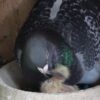
Chick Mortality in the First Week: Causes, Prevention, and Solutions for Racing Pigeon Breeders
Few things are as heartbreaking for pigeon breeders as losing squabs within the first week of life. You watch your breeders do everything right—pair up, lay eggs, incubate faithfully—and then, just days after hatching, the chicks die. Whether you’re managing a small loft or preparing a team of future champions, early chick mortality can drastically impact your productivity, performance outcomes, and genetic continuity.
In this blog post, we’ll explore the most common causes of first-week chick mortality in racing pigeons, how to spot the warning signs early, and—most importantly—how to create a preventive plan that gives every squab the best possible start.
Why Is the First Week So Critical?
The first seven days of a pigeon chick’s life are the most vulnerable. During this time, chicks rely entirely on their parents for warmth, food (mainly crop milk), and protection. Any disruption—whether it’s disease, poor loft hygiene, or neglect—can spell disaster for these fragile hatchlings.
Even experienced breeders can occasionally lose chicks during this window, but if early deaths are happening regularly, it’s time to evaluate your loft management and health protocols.
Common Causes of Chick Mortality in the First Week
Here are the top causes of chick mortality, based on experience, field data, and vet insight:
1. Poor Loft Hygiene
Dirty nest boxes, soiled bedding, or contaminated water sources can quickly become breeding grounds for bacteria and parasites. Newly hatched chicks have underdeveloped immune systems and can’t fight off infections easily.
Key offenders:
2. Parental Neglect or Inexperience
Young or stressed breeders may not feed their chicks adequately or fail to keep them warm. Poor parenting can lead to dehydration, starvation, and cold stress—all fatal for squabs.
Watch for signs of neglect:
-
Empty crops for prolonged periods
-
Parents leaving the nest too often
-
Shivering or weak chicks
3. Bacterial or Fungal Infections
Bacterial infections are a leading cause of first-week mortality. These often enter through the navel (belly button area) or crop when chicks are fed contaminated food or water. Fungal infections, like Aspergillosis, can also affect the respiratory system, especially in dusty, moldy lofts.
Symptoms:
-
Swollen abdomen
-
Yellowish diarrhea
-
Lethargy
-
Crop stasis or sour crop
4. Environmental Stress
Cold drafts, sudden temperature drops, or excessive humidity can make it impossible for chicks to regulate their body temperature. Heat lamps or well-insulated nest boxes are essential during colder months.
The Domino Effect on the Loft
Chick mortality is not just a one-time loss—it creates a domino effect:
-
Reduces future racing prospects
-
Delays breeding schedules
-
Wastes energy and resources
-
Causes emotional stress for breeders
-
Potentially spreads illness to other squabs
If multiple chicks die in a short period, assume it’s an environmental or bacterial issue, not just bad luck.
Effective Prevention Strategies for First-Week Chick Mortality
Prevention begins before the eggs are even laid. Here’s how to improve hatchling survival:
1. Maintain Loft Hygiene
-
Clean nest bowls thoroughly between every breeding round.
-
Disinfect feeders, drinkers, and perches regularly.
-
Replace nesting material weekly or whenever it becomes soiled.
-
Use vet-approved disinfectants that kill bacteria, viruses, and fungi without harming birds.
Pro Tip: Sprinkle diatomaceous earth or a pigeon-safe disinfectant powder in the nest bowl to reduce mite and bacterial load.
2. Use Broad-Spectrum Antibacterials Judiciously
If your loft has a history of bacterial issues during breeding, a broad-spectrum antibacterial may be needed as a preventive measure. Products containing amoxicillin or enrofloxacin are commonly used, but always consult a vet for dosage and timing.
Only treat birds when absolutely necessary to avoid creating resistance.
3. Supplement With Probiotics
Adding probiotics to the drinking water or directly into the crop helps populate the digestive system with good bacteria, improving nutrient absorption and boosting the chick’s immune defense against harmful microbes.
Look for a pigeon-specific blend that includes Lactobacillus and Bifidobacterium species.
4. Monitor Parental Behavior
-
Avoid pairing two first-time breeders together.
-
Keep stress levels low—avoid excessive handling or loud disturbances.
-
Ensure breeders are getting a balanced diet rich in calcium and amino acids before and during breeding.
If a pair is known for poor parenting, consider swapping eggs or chicks to foster pairs.
5. Stabilize the Nest Environment
-
Keep the loft dry and well-ventilated.
-
Avoid sudden temperature changes—use heating pads or infrared heat lamps in colder climates.
-
Shield nests from direct drafts or exposure to cold.
Supporting Chicks Through Their First Week
Even with all the preventive care, you should still be ready to act fast if a chick starts showing signs of distress. Here’s what you can do:
If the Chick Is Cold:
-
Use a small heated box or cup warmer with a soft towel.
-
Gradually raise the chick’s temperature—never shock it with high heat.
If the Chick Isn’t Being Fed:
-
Consider hand-feeding with crop milk substitute for the first few days.
-
Use a syringe and soft rubber tube, feeding slowly and gently.
-
Monitor crop filling and ensure digestion is working properly.
If There’s Diarrhea or Swelling:
-
Isolate the chick immediately.
-
Administer an electrolyte/probiotic solution.
-
Consult your vet about a suitable antibiotic or antifungal treatment.
Long-Term Improvements to Your Breeding Program
Reducing chick mortality isn’t just about the current breeding season—it strengthens your entire loft’s future performance. By optimizing hygiene, nutrition, and health protocols now, you create a foundation for stronger, faster, and more resilient racing pigeons down the line.
Consider incorporating the following into your routine:
-
Breeder conditioning programs 2–4 weeks before pairing
-
Routine droppings analysis or crop swabs during the breeding season
-
Seasonal use of natural supplements like oregano oil, garlic extract, and multivitamins
Final Thoughts
Chick mortality in the first week is frustrating—but more often than not, it’s preventable. Understanding the underlying causes and implementing a loft-wide prevention plan can mean the difference between a disappointing season and a thriving one.
Start with hygiene, add probiotics, monitor breeder behavior, and be prepared with broad-spectrum treatments when needed. Your vigilance today leads to stronger flocks, better breeding outcomes, and ultimately, winning pigeons.


